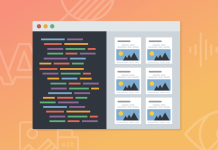Who doesn’t love a good old-fashioned debate? You’re guaranteed to start a conversation by wondering aloud if pineapple should be on pizza or if a hot dog is truly considered a sandwich (I’m a big N-O for both, if you’re wondering.)

Light mode vs. dark mode: Which is better?
That’s kind of a trick question. Dark mode is here to stay, and increasingly popular. One isn’t better than the other…you’re going to have to do the work needed for both. Let’s start by deep diving into the dark mode vs. light mode debate:
Dark mode and readability
Dark text on a white background (aka light mode) became the standard for most digital interfaces with the rise of word processors, which emulated the look of ink on paper.
It’s contrast (and context) that matters more than the choice of mode, here. If you’re reading longform articles like this one at night, dark mode might be more difficult to read. But it can be easier to interact on social media, make quick decisions, or might simply be your preference.
Dark mode and blue light exposure
The last few years have seen a few solutions for the way technology disrupts circadian rhythms.
Software like Fl.ux claims to shift the background light on your laptop or phone to more closely mirror outdoor conditions and away from “blue light.” Studies have shown exposure to blue light from phones or other devices in the hours before bed suppresses the body’s production of melatonin, the hormone that induces drowsiness.
Blue light from our screens is also linked to digital eye strain as well as symptoms such as dry eyes, blurry vision, headaches, and sleeplessness. In fact, research published in the science journal Nature found that long-term exposure to bright screens is linked to myopia, or nearsightedness. One way to combat this is by reducing the brightness of the screen, or activating dark mode.
While dark mode may be easier to read at night, it’s not necessarily going to fix these issues. According to the American Academy of Ophthalmology (AAO), it’s the way we use our devices that creates eye strain, rather than the type of light. The best way to sleep better and reduce the chance of myopia is to actually rest—no phone in sight.
Dark mode and battery life
One common marketing claim is that dark mode saves battery life. That’s true…sometimes.
According to a 2021 Purdue University study, using your phone’s default auto-brightness setting at 30-40%, switching from light mode to dark mode saves only 3%-9% power, and only on OLED screens (organic light-emitting diode, most common on smartphones released after 2017.) Translation: You’ll only experience energy savings if your phone uses an OLED screen. Regular ‘ol LCD screens more commonly found on laptops or tablets don’t necessarily see any benefits.
As dark mode continues to rise in popularity, and as apps more accurately track their energy usage, we may see more energy conservation benefits in the future. In the meantime, dark mode can technically extend your battery life, but not by much.
Dark mode and accessibility
Dark mode is often described as more accessible, but that depends on who you ask. Darker screens can help with those more sensitive to light or in low-light conditions and can reduce overall eye strain because of less contrast.
According to the Bureau of Internet Accessibility (BOIA), however, people with conditions such as dyslexia (affecting an estimated 5-10% of the US population), and astigmatism may struggle to read the text in dark mode.
What developers need to know about dark mode
- “Is there anything that can be done to prevent dark mode from changing our text from black to white?”
- “Is there any ‘easy’ way to automatically switch the whole HTML to dark mode, whenever possible?”
- “I am having an issue in the rendering of my custom coded HTML Email template in Dark Mode. The email and all the colors work perfectly fine except this one top header.”
| Email Client | Auto-Inverts Colors? | Common Dark Mode Challenge |
| Apple Mail (iPhone/iPad) |
Yes | Auto inverts when the background is transparent or pure white (#fffff). |
| Apple Mail (macOS) |
Yes | Auto inverts when the background is transparent or pure white (#fffff). |
| Outlook (iOS) |
Partially | May make background color darker. |
| Outlook (macOS) |
Partially |
The only Outlook option that does support @media (prefers-color-scheme). May make background color darker. |
| Outlook (Windows) |
Yes | The only Outlook option that consistently auto-inverts colors. |
| Outlook.com (webmail) |
Partially |
The only Outlook option where image swap works. May make background color darker. |
| Gmail (Android) |
Yes (when not already dark) |
Does not support the query @media (prefers-color-scheme). |
| Gmail (webmail) |
No | Does not support the query @media (prefers-color-scheme). |
| AOL (webmail) |
No | No current dark mode user interface. |
| Yahoo! (webmail) |
No | No current dark mode user interface. |
A few tips to get you started coding for dark mode:
- Work with your branding team on interpreting logo, color scheme, and other brand elements in dark mode
- Use PNGs with transparent backgrounds
- Use white strokes around black design elements
- Watch for vanishing images or logos
- Add workarounds in the code to address dark mode specifically

Results from dark mode experiments and surveys

It’s time to join the dark side.
How Email on Acid can help with dark mode emails








